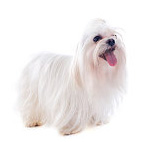
Maltese pros and cons
Maltese owners report many pros associated with owning this tiny dog breed. Maltese pros include the dog's convenient size - the small sized dog can be picked up and carried during a long walk. Other pros include Maltese's sweet and affectionate personality which makes this breed an excellent companion pet for single people and for older owners. Maltese dogs are playful and sociable. Do Maltese dogs need a lot of exercise? Maltese have reasonable exercise requirements, making these small white dogs very suitable for living in an apartment. Three half an hour walks per day in addition to some playtime are necessary to keep your Maltese healthy and happy.
Are Maltese hypoallergenic? Other good points about Maltese dogs include the fact that a Maltese breed is hypoallergenic and the dog does not produce a lot of shedding - only a few dead hairs every day. People with pet related allergies may consider a Maltese breed as one of the safer options. (Always test your allergies around the dog before making the final commitment). Despite low-shedding coat, Maltese need to be brushed daily in order to prevent mats and tangles.
Owning a Maltese also has some cons. Maltese cons include the size of the dog - although having a small dog has its advantages, the disadvantages are also present. For example, a small Maltese can be easily hurt and owners who accidentally step on the dog or sit on the dog can seriously hurt the tiny Maltese. Maltese owners mention that the dog can be demanding for attention and over-dependent. Maltese's coat is high maintenance which can be a disadvantage for owners who do not have the time that it takes to care for Maltese's coat. The breed is most suitable for older people who have the time and energy to dedicate to pampering their small pet. Other cons associated with the Maltese breed include difficulties that many Maltese owners encounter during housetraining. Not all small dog breeds have this issue. The Maltese breed can be difficult to housebreak. Excessive barking and separation anxiety are other cons to consider when selecting a Maltese breed.
Maltese size
Maltese weight
Maltese male weight: 6 to 8 lb (3 to 4 kg)
Maltese female weight: 6 to 8 lb (3 to 4 kg)
How big do Malteses get?
Maltese male height: 8 to 10 in (21 to 25 cm)
Maltese female height: 8 to 9 in (20 to 23 cm)
Maltese coat: silky, long and straight
Maltese colors: pure white
How many puppies does a Maltese have?
Maltese litter size: 1 to 5 puppies
How long do Maltese dogs live?
Maltese lifespan: 12 to 15 years
How much does a Maltese cost?
Maltese price starts at around $1,000 per puppy and up, depending on many factors
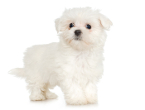
Maltese temperament
Among the smallest of the Toy Group, the Maltese are bred to be cuddly companion dogs. Maltese temperament is lively and playful, and even as a Maltese ages, the energy level and playful demeanor remain fairly constant. Are Maltese good with kids? Some Maltese may occasionally be snappish with children and should be supervised when playing, although socializing them at a young age will reduce this habit. Many Maltese breeders do not recommend getting this breed if you have young children at home. The tiny dog is too easy to hurt and children may easily injure this delicate toy breed. Adults also need to be careful when sitting down on a couch where the small dog might be curling up under the cover. It is very easy to injure the dog by accidentally stepping on it or sitting on it. When outside, watch out for other larger dog breeds that may view your precious Maltese as a tasty lunch. The small dog size can be convenient for the owner as the dog is easy to transport and to keep in a small apartment, but there are some cons to the tiny dog size as the owner should always think of the dog's safety due to the mini size. Maltese adore humans, and prefer to stay near the people they love. The Maltese is very active within a house, and, preferring enclosed spaces, does very well with small yards. Make sure to check the fence for any gaps where your Maltese can squeeze through and run away before letting the dog in the yard. Because of the Maltese miniature size, the breed fares well in apartments and townhouses, and is a prized pet of urban dwellers. The white and silky coat of this dog is hypoallergenic and produces much less dander than many other breeds. This is one of the reasons why this small, low shedding white dog is so popular among dog owners with pet dander allergies. Please be aware that no dog breed is completely free from allergens but some breeds produce less dander than others and therefore are considered hypoallergenic. Do Maltese shed? Even though the Maltese does not shed much, the coat requires daily maintenance. Nonshedding coat is suitable for allergy sufferers. If you have pet allergies, be sure to spend some time with the dog before committing to purchasing the Maltese. The Maltese breed is a good choice for owners that enjoy grooming their pets daily to keep the coat healthy and prevent mats and tangles from forming. How to groom a Maltese is explained below along with helpful Maltese grooming videos.
Some Maltese may suffer from separation anxiety. Do not get this breed if you are planning to leave your dog alone for long periods of time. Maltese are essentially companion dogs that need company in order to thrive. Stuffable dog toys help to keep Maltese dog busy figuring out how to get the treats out. Stuffable toys help to keep the dog more active both mentally and physically. If you need to leave a Maltese alone for a while, leave a stuffable toy to keep the dog busy while you are away.
Do Maltese dogs bark a lot? One of the cons to owning a Maltese dog is that Maltese dogs love to bark. Maltese dogs bark a lot for many reasons, including excitement, boredom and when something out of ordinary happens. The good news is that a Maltese can be trained to not bark on command, which can be very convenient especially for people who live in a city environment and want to minimize the amount of dog barking out of consideration for neighbors.
Training a Maltese puppy
Potty training a Maltese should begin the moment the dog arrives to your home. Pay close attention to his behavior and if you notice that the dog is starting to sniff the floor and walk around in circles, immediately take the Maltese to the designated dog toilet area. Let the Maltese do what he needs to do there and as soon as the dog is done, reward him with a praise and a small treat. When you are taking the dog to his potty area, you may say a command for potty, such as "Go Potty!" so that the dog will learn to associate the command with going potty. This command can be very useful especially when you are short on time or traveling and need the dog to go potty. Be prepared for accidents that are bound to happen during potty training the Maltese. Do not punish the dog for accidents - clean up the mess and be on the look out for his readiness to use the toilet the next time. It is important to throughly remove any trace of the dog's urine from any area that is not meant to be his toilet. Dogs associate the smell of their urine with potty area and may be tempted to use that area as his toilet in the future. Use a dog odor remover spray to completely get rid of any urine scent where the dog soiled the floor.
Maltese dogs can also be trained to use an indoor dog potty. Indoor dog potty can help to avoid any accidents in case the dog missed his walk or if there's too much time between walks and his small bladder can only hold it in for so long. Indoor potty is a kind way to allow your dog use the toilet whenever he has to go.
Even a tiny Maltese dog needs to have good manners. Obedience training can help establish good manners and make the bond between the owner and the dog stronger. The Maltese respond well to positive reinforcement training methods that include food, praise, play and encouragement. Observe your dog to determine which motivator works best for your pet.
The Maltese dog should be trained to come to you when called, to know the important commands such as sit, stay, place, heal and "Quiet!". The "Quiet!" command is useful because it will help you to stop the dog from barking. Some Maltese really enjoy barking and if your neighbors are sensitive to the noise made by your little angel - manage this barking problem by saying "Quiet!" when the dog starts barking for no reason. And as soon as the dog stops barking, reward him with a treat. The dog needs to make connection between stopping to bark when asked and getting a reward for the good behavior. The "Quiet!" command may take a while for your dog to understand but with patience you will get good results.
Keep training sessions short, preferably under five minutes per session and always end a training session on a positive note. You can have several five-minute training sessions every day. Immediately reward the Maltese when the dog does what is asked of it. When Maltese dog does something that it's not supposed to do, say "No!" and redirect the dog's focus to something else. Harsh training methods should never be used. Housetraining should start the moment you bring a Maltese puppy home. As long as you are consistent and patient you will succeed.
The Maltese enjoy chewing on things, so a nice chewing toy or a rawhide bone is a good way to keep your dog happy and your shoes safe.
Maltese dog accessories
A Maltese is a toy breed, but even small dogs need to be trained to walk on a leash. A soft harness is a good option for small dog breeds such as the Maltese. A dog harness is usually more gentle on the dog's small neck especially when the Maltese likes to pull on the leash while walking. When the dog is wearing a collar, it puts more pressure on the dog's neck and trachea area. A harness does not put as much pressure on the dog's neck and distributes the pulling pressure in a safer way. For larger breeds collars help to maintain a better control over the dog, but with a small dog such as the Maltese that does not have excessive strength, getting a harness instead of a collar is a good idea.
Dog harness for Maltese
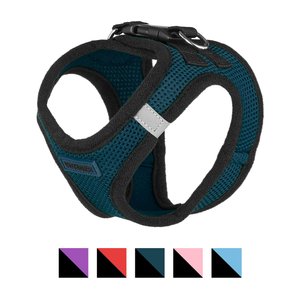
• Best Pet Supplies Voyager Black Trim Mesh Dog Harness comes in several different colors
• Suitable for Maltese breed
• Gentle on Maltese's skin and coat
• 2-D rings for easy leash attachment
Dog carriers for Maltese
A small sized dog such as the Maltese is light enough to be carried in a dog carrier. Dog carriers for Maltese are very convenient especially if your Maltese is older and can no longer easily handle longer walks.
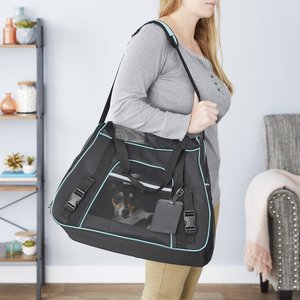
• This pet carrier is suitable for Maltese dogs and works great for other small dog breeds
• Mesh panels circulate air in the bag and keep your Maltese comfortable
• Shoulder straps make this pet carrier easy to carry
• Auto-locking zippers
Pet strollers for Maltese dogs
While dog carriers work great for traveling, getting a Pet Stroller may be a wonderful option Maltese owners who want to transport their pet in a comfortable stroller. Strollers are especially popular in cities where a small dog may not be safe around crowded streets and the owner may use the stroller to easily take the dog to the dog park without taking any chances while getting there.
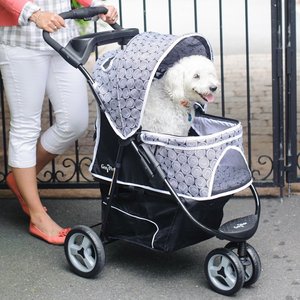
• Gen7Pets Promenade Pet Stroller is available in a variety of colors
• Mesh windows keep your Maltese cool and comfortable
• Front wheels feature shock absorbers so your Maltese dog can enjoy a smooth ride
• Washable and removable pad
• Accessory compartment as well as cup holder is available
Dog crates for Maltese
Crate training a Maltese will help you and the dog during longer traveling, including car trips. Crate trained dogs are easier to travel with as the familiar environment of the crate calms the dog down during the trip to a new destination. Crates can also be used for Maltese potty training as dogs tend to avoid soling the area where they sleep. If crated for a long time any dog will have an accident. Do not leave the dog locked in a crate for longer than an hour or two. Crates are very useful for Maltese puppies that tend to get in trouble when left alone for any period of time. A crate can be a safe environment for the puppy if you are unable to supervise him and need to leave for an hour or so. Crate training should ideally start while the puppy is still young, but even an adult Maltese can be successfully crate trained. Never use a crate as a way to punish the dog because the dog may associate the crate with getting punished instead of associating it with a safe place where the dog can comfortably rest and sleep. The right crate size for the Maltese should be big enough for the dog to stand full height and to stretch out while laying down. The dog should easily turn around in the crate. If the crate is too big, the dog will be tempted to use the unused space as his toilet, which is not ideal.
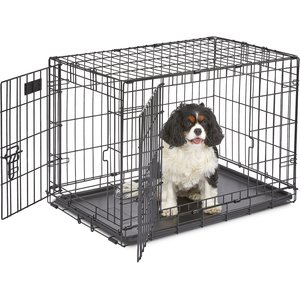
• MidWest iCrate Fold & Carry Double Door Collapsible Wire Dog Crate comes in different sizes
• Folds for easier storage
• Free divider panel for a growing Maltese puppy
Maltese care
Prone to sunburn along the hair parting, skin, eye issues, respiratory, and slipped stifle. Some Maltese may be difficult to feed with weak, upset digestion. They may get the chills, and experience discomfort in hot weather. Maltese should be kept out of damp areas.
The sweater for small Maltese can help to keep the dog warm during the cooler weather outside.
Maltese health problems
The Maltese may suffer from deafness, shaker syndrome, and dental health problems. There are other minor health issues such as patellar luxation, hydrocephalus, open fontanel, hypoglycemia, distichiasis, entropion, hypothyroidism, and portacaval shunt associated with the Maltese dog breed. Your veterinarian may run knee, eye, and thyroid exams on this breed of dog to identify some of these issues.
Feeding a Maltese a healthy diet is an investment into the dog's health and longevity. Maltese are small dogs that do not eat much and the dog's health and appearance will benefit from getting a nutritious dog food. Breed specific dog food is a good option because the food is designed to meet the nutritious needs of the Maltese breed.

• This dog food is formulated with the specific needs of the Maltese breed in mind
• Dry kibble is designed to be comfortable to chew for a Maltese dog
• Highly digestible and suitable for food-sensitive Maltese dogs
• Promotes skin and coat health
• Great for picky eaters
Maltese origin
One of the oldest dog breeds and the most ancient European toy breed, the Maltese has an interesting history. The first Maltese dogs were discovered by the Phoenician sailors visiting the island of Malta, located in the Mediterranean sea near the coast of Italy for trading around 1500 B.C. From the 5th century onwards, Greek art features dogs that look very much like the modern day Maltese breed. There is also evidence that the Greeks built tombs to honor the Maltese.
The Maltese was introduced to England in the early 1300s. Upper-class ladies took a fancy to them for their diminutive size. However, it was not until the 1877 Westminster Kennel Club dog shows that the first Maltese was exhibited in the United States. The American Kennel Club accepted the Maltese for registration in 1888. Since then, the Maltese has steadily grown in popularity and is one of the most coveted toy breeds today.
|